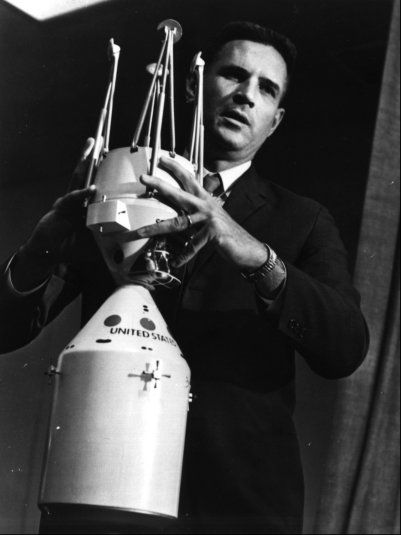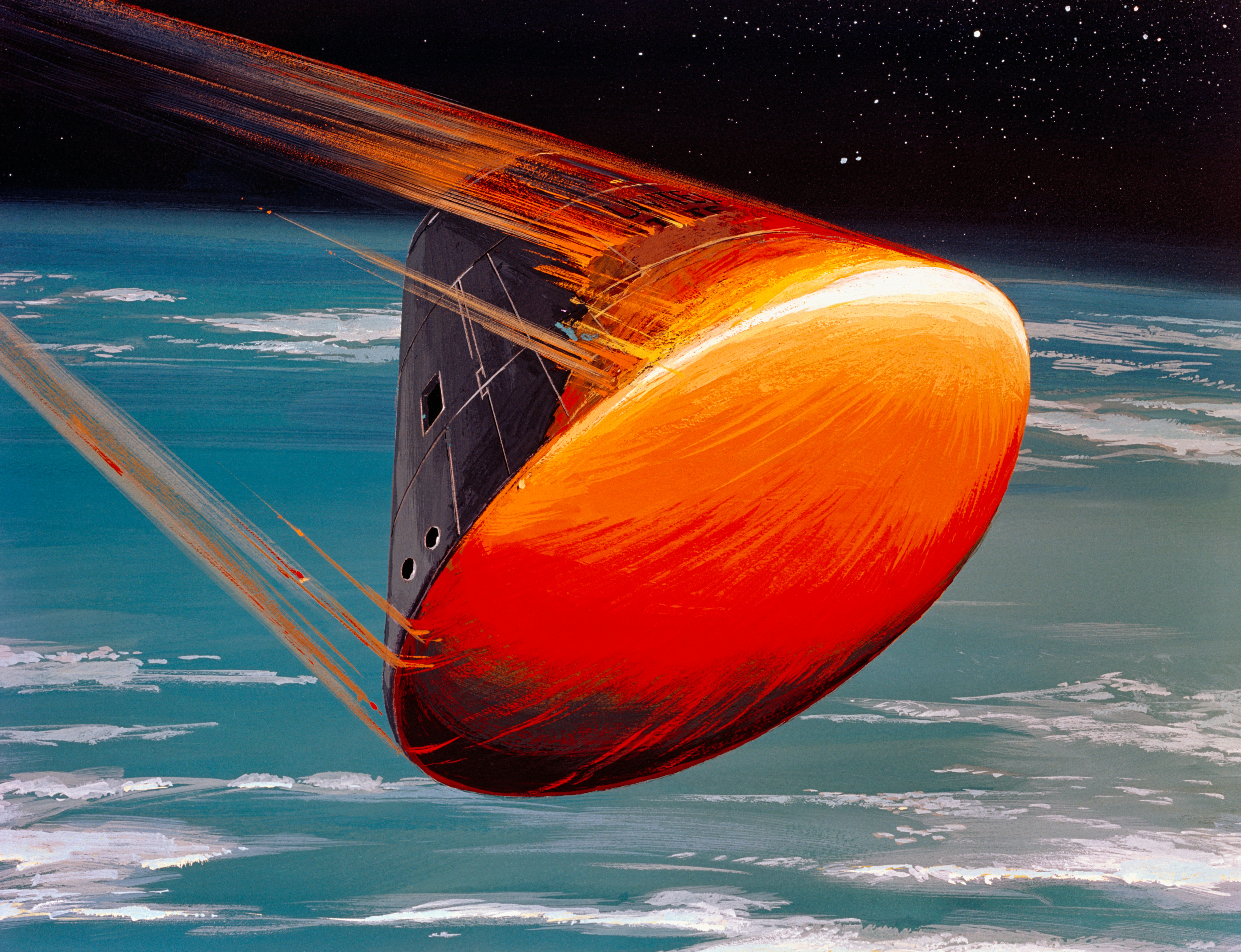|
Saturn V Dynamic Test Vehicle
The Saturn V dynamic test vehicle, designated SA-500D, is a prototype Saturn V rocket used by NASA to test the performance of the rocket when vibrated to simulate the shaking which subsequent rockets would experience during launch. It was the first full-scale Saturn V completed by the Marshall Space Flight Center (MSFC). Though SA-500D never flew, it was instrumental in the development of the Saturn V rocket which propelled the first men to the Moon as part of the Apollo program. Built under the direction of Dr. Wernher von Braun, it served as the test vehicle for all of the Saturn support facilities at MSFC. SA-500D is the only Saturn V on display that was used for its intended purpose, and the only one to have been assembled prior to museum display. It is on permanent display at the U.S. Space & Rocket Center, Huntsville, Alabama. Pre-flight configurations Before a Saturn V could be launched, engineers needed to verify that their design had accounted for everything the ro ... [...More Info...] [...Related Items...] OR: [Wikipedia] [Google] [Baidu] |
Saturn V Dynamic Test Stand
Saturn V dynamic test stand, also known as dynamic structural test facility, at the George C. Marshall Space Flight Center in Huntsville, Alabama is the test stand used for testing of the Saturn V rocket and the Space Shuttle prior to the vehicles' first flights. Designated building 4550, it stands tall and is square. Its central bay has maximum dimensions of , and it is topped by a derrick capable of moving 200-ton objects in a radius. An elevator provides access to 15 levels in the structure, and a cable tunnel connects the building to control facilities in the space center's East Test Area. NASA built the test stand in 1964 to conduct mechanical and vibrational tests on the fully assembled Saturn V rocket. Major problems capable of causing failure of the vehicle were discovered and corrected here. The new building was so tall that in 1966 when the Saturn V first stage was entering, an observer noted, "Fog and clouds hovered around the top of the tall test stand most of ... [...More Info...] [...Related Items...] OR: [Wikipedia] [Google] [Baidu] |
S-II
The S-II (pronounced "S-two") was the second stage of the Saturn V rocket. It was built by North American Aviation. Using liquid hydrogen (LH2) and liquid oxygen (LOX) it had five J-2 engines in a quincunx pattern. The second stage accelerated the Saturn V through the upper atmosphere with of thrust. History The beginning of the S-II came in December 1959 when a committee recommended the design and construction of a high-thrust, liquid hydrogen fueled engine. The contract for this engine was given to Rocketdyne and it would be later called the J-2. At the same time the S-II stage design began to take shape. Initially it was to have four J-2 engines and be in length and in diameter. In 1961 the Marshall Space Flight Center began the process to find the contractor to build the stage. Out of the 30 aerospace companies invited to a conference where the initial requirements were laid out, only seven submitted proposals a month later. Three of these were eliminated after their p ... [...More Info...] [...Related Items...] OR: [Wikipedia] [Google] [Baidu] |
Los Angeles, California
Los Angeles, often referred to by its initials L.A., is the List of municipalities in California, most populous city in the U.S. state of California, and the commercial, Financial District, Los Angeles, financial, and Culture of Los Angeles, cultural center of Southern California. With an estimated 3,878,704 residents within the city limits , it is the List of United States cities by population, second-most populous in the United States, behind only New York City. Los Angeles has an Ethnic groups in Los Angeles, ethnically and culturally diverse population, and is the principal city of a Metropolitan statistical areas, metropolitan area of 12.9 million people (2024). Greater Los Angeles, a combined statistical area that includes the Los Angeles and Riverside–San Bernardino metropolitan areas, is a sprawling metropolis of over 18.5 million residents. The majority of the city proper lies in Los Angeles Basin, a basin in Southern California adjacent to the Pacific Ocean in the ... [...More Info...] [...Related Items...] OR: [Wikipedia] [Google] [Baidu] |
Douglas Aircraft Company
The Douglas Aircraft Company was an American aerospace manufacturer, aerospace and military, defense company based in Southern California. Founded in 1921 by Donald Wills Douglas Sr., it merged with McDonnell Aircraft in 1967 to form McDonnell Douglas, where it operated as a division. History 1920s The company was founded as the Douglas Company by Donald Wills Douglas Sr. on July 22, 1921, in Santa Monica, California, following dissolution of the Davis-Douglas Company. An early claim to fame was the first aerial circumnavigation, first circumnavigation of the world by air in Douglas airplanes in 1924. In 1923, the U.S. Army Air Service was interested in carrying out a mission to circumnavigate the Earth for the first time by aircraft, a program called "World Flight". Donald Douglas proposed a modified Douglas DT to meet the Army's needs. The two-place, open cockpit DT biplane torpedo bomber had previously been produced for the United States Navy, U.S. Navy.Rumerman, Judy. "The D ... [...More Info...] [...Related Items...] OR: [Wikipedia] [Google] [Baidu] |
Kennedy Space Center
The John F. Kennedy Space Center (KSC, originally known as the NASA Launch Operations Center), located on Merritt Island, Florida, is one of the NASA, National Aeronautics and Space Administration's (NASA) ten NASA facilities#List of field centers, field centers. Since 1968, KSC has been NASA's primary launch center of American spaceflight, research, and technology. Launch operations for the Apollo Program, Apollo, Skylab and Space Shuttle Program, Space Shuttle programs were carried out from Kennedy Space Center Launch Complex 39 and managed by KSC. Located on the east coast of Florida, KSC is adjacent to Cape Canaveral Space Force Station (CCSFS). The management of the two entities work very closely together, share resources, and operate facilities on each other's property. Though the first Apollo flights and all Project Mercury and Project Gemini flights took off from the then-Cape Canaveral Air Force Station, the launches were managed by KSC and its previous organization, ... [...More Info...] [...Related Items...] OR: [Wikipedia] [Google] [Baidu] |
Apollo 6
Apollo 6 (April 4, 1968), also known as AS-502, was the third and final uncrewed flight in the United States' Apollo Program and the second test of the Saturn V launch vehicle. It qualified the Saturn V for use on crewed missions, and it was used beginning with Apollo 8 in December 1968. Apollo 6 was intended to demonstrate the ability of the Saturn V's third stage, the S-IVB, to propel itself and the Apollo spacecraft to lunar distances. Its components began arriving at the Kennedy Space Center in early 1967. Testing proceeded slowly, often delayed by testing of the Saturn V intended for Apollo 4—the inaugural launch of the Saturn V. After that uncrewed mission launched in November 1967, there were fewer delays, but enough so that the flight was postponed from March to April 1968. The flight plan called for, following trans-lunar injection, a direct return abort using the service module's main engine with a flight time totaling about 10 hours but vibrations damaged some o ... [...More Info...] [...Related Items...] OR: [Wikipedia] [Google] [Baidu] |
Lunar Module
The Apollo Lunar Module (LM ), originally designated the Lunar Excursion Module (LEM), was the lunar lander spacecraft that was flown between lunar orbit and the Moon's surface during the United States' Apollo program. It was the first crewed spacecraft to operate exclusively in the airless vacuum of space, and remains the only crewed vehicle to land anywhere beyond Earth. Structurally and aerodynamically incapable of flight through Earth's atmosphere, the two-stage Lunar Module was ferried to lunar orbit attached to the Apollo command and service module (CSM), about twice its mass. Its crew of two flew the Lunar Module from lunar orbit to the Moon's surface. During takeoff, the spent descent stage was used as a launch pad for the ascent stage which then flew back to the command module, after which it was also discarded. Overseen by Grumman, the LM's development was plagued with problems that delayed its first uncrewed flight by about ten months and its first crewed flight by ... [...More Info...] [...Related Items...] OR: [Wikipedia] [Google] [Baidu] |
Apollo Service Module
The Apollo command and service module (CSM) was one of two principal components of the United States Apollo spacecraft, used for the Apollo program, which landed astronauts on the Moon between 1969 and 1972. The CSM functioned as a mother ship, which carried a crew of three astronauts and the second Apollo spacecraft, the Apollo Lunar Module, to lunar orbit, and brought the astronauts back to Earth. It consisted of two parts: the conical command module, a cabin that housed the crew and carried equipment needed for atmospheric reentry and splashdown; and the cylindrical service module which provided propulsion, electrical power and storage for various consumables required during a mission. An umbilical connection transferred power and consumables between the two modules. Just before reentry of the command module on the return home, the umbilical connection was severed and the service module was cast off and allowed to burn up in the atmosphere. The CSM was developed and built ... [...More Info...] [...Related Items...] OR: [Wikipedia] [Google] [Baidu] |
Launch Escape System
A launch escape system (LES) or launch abort system (LAS) is a crew-safety system connected to a space capsule. It is used in the event of a critical emergency to quickly separate the capsule from its launch vehicle in case of an emergency requiring the abort of the launch, such as an impending explosion. The LES is typically controlled by a combination of automatic rocket failure detection, and a manual activation for the crew commander's use. The LES may be used while the launch vehicle is on the launch pad, or during its ascent. Such systems are usually of three types: *A solid-fueled rocket, mounted above the capsule on a tower, which delivers a relatively large thrust for a brief period of time to send the capsule a safe distance away from the launch vehicle, at which point the capsule's parachute recovery system can be used for a safe landing on ground or water. The escape tower and rocket are jettisoned from the space vehicle in a normal flight at the point where it is eit ... [...More Info...] [...Related Items...] OR: [Wikipedia] [Google] [Baidu] |
Apollo Command Module
The Apollo command and service module (CSM) was one of two principal components of the United States Apollo (spacecraft), Apollo spacecraft, used for the Apollo program, which landed astronauts on the Moon between 1969 and 1972. The CSM functioned as a mother ship, which carried a crew of three astronauts and the second Apollo spacecraft, the Apollo Lunar Module, to lunar orbit, and brought the astronauts back to Earth. It consisted of two parts: the conical command module, a cabin that housed the crew and carried equipment needed for atmospheric reentry and splashdown (spacecraft landing), splashdown; and the cylindrical service module which provided propulsion, electrical power and storage for various consumables required during a mission. An umbilical cable, umbilical connection transferred power and consumables between the two modules. Just before reentry of the command module on the return home, the umbilical connection was severed and the service module was cast off and al ... [...More Info...] [...Related Items...] OR: [Wikipedia] [Google] [Baidu] |








